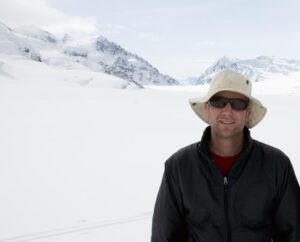Kreutz consults on ‘Arctic Adventure’ exhibit at Boston Museum of Science
Growing up alongside the Niagara River in New York, Karl Kreutz loved the winter storms that dumped feet of snow and he enjoyed watching ice from Lake Erie flow past his house en route to Niagara Falls.

“I didn’t know it at the time, but it really was like an Arctic landscape right in my front yard,” he says.
When he learned in a college glacial geology course that a two-mile-thick ice sheet had covered a large swath of the continent until about 15,000 years ago, things clicked.
“I realized I could have a career that combined my interest in science and my love of the outdoors,” he says.
Today, the professor in the Climate Change Institute and the School of Earth and Climate Sciences at the University of Maine seeks to better understand Earth’s dynamic climate history. And he does that in spectacular ice-covered landscapes, including in Alaska, Antarctica, Asia, Canada, Greenland, Iceland and South America.
A little over two years ago, the Museum of Science (MOS) in Boston asked Kreutz for his scientific expertise as it planned and developed a permanent exhibit “Arctic Adventure: Exploring with Technology.”
Kreutz welcomed the opportunity to work on the project that seeks to spark people’s excitement for the Arctic, technology, science and exploration.
“In my 20-plus years of working in polar regions, there have been incredible advances in communication, GPS, remote sensing, and other technology, including the laboratory resources we have at UMaine, that allow for more and exciting discoveries,” he says.
Kreutz served with colleagues from NASA and the Massachusetts Institute of Technology, among others, on the panel of consultants for the exhibit, which opened earlier in December. The Moment Factory also teamed with the MOS to expand “the boundaries of exhibition design with augmented learning.”
Museumgoers, Kreutz says, can feel, hear, see and experience what it’s like to be a polar explorer.
The exhibit’s four distinct zones have “real-time content fine-tuned to change everything from sunlight hues and animal behaviour to the hour and season,” according to the Moment Factory.
Throughout the visit, museumgoers encounter a variety of sounds, including seal and whale calls. In an ice cave surrounded by real, touchable ice walls, they’ll feel the temperature plummet.
Guests also can experience what it’s like to drill, and analyze, an ice core, as well as use ground-penetrating radar to safely cross a virtual glacier. And they can utilize GPS to track migrations of polar bears and whales.
After two years of offering insights about science, ice-coring and Arctic landscapes, Kreutz says he’s eager to experience the exhibit firsthand. Perhaps there, he’ll encounter a youth being inspired to pursue a career like his.

